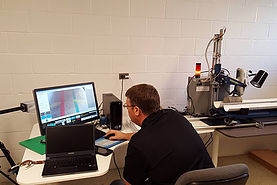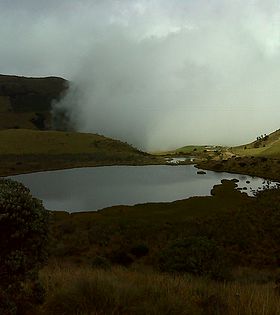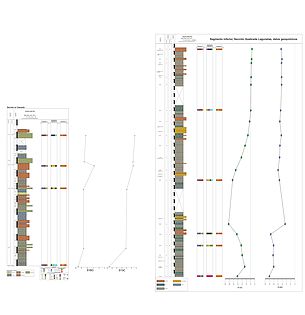Research

The main research of the Carbonate Sedimentology and Geochemistry Group focuses on the evolution of the carbonate fabrics through time and its relationship to major global environmental and biogeochemical changes. Our research also focuses on the characterization of potential carbonate reservoirs, as well as, on sedimentary basin analysis. Our research uses multi-proxy approaches including field mapping, sedimentology, stratigraphy, petrography and isotope and elemental geochemistry. Current projects primarily focus on 1) characterization of Cenozoic and Cretaceous carbonate platforms along the Circum Caribbean and 2) investigation of past changes in ocean oxygenation and acidification during periods of hig atmospheric pCO2, i.e Proterozoic, Permian-Triassic, Cretaceous OAEs.
Our research also extend into 1) Holocene paleoclimate evolution along the Neotropics and its consequences on the pre-Hispanic cultures, 2) evolution of the Cenozoic continental sedimentary record along northern South America and its bearings on the Neotropic climate and northern South America paleogeography.
Our research also extend into 1) Holocene paleoclimate evolution along the Neotropics and its consequences on the pre-Hispanic cultures, 2) evolution of the Cenozoic continental sedimentary record along northern South America and its bearings on the Neotropic climate and northern South America paleogeography.
News

UNIVERSITY of HOUSTON Present at GSA 2016



Closure of the Panama Seaway occurred earlier than previously though. Discover challenges paradigms of modern climate and biologic evolution.
The closure of the Panama Seaway has been for long time considered to have occurred 3 million years ago. The closure of the Panama Seaway, which separated the Pacific from the Atlantic oceans, has been associated to one of the biggest biological exchanges in Earth history, i.e. the Great American Biological Interchange (GABI). The closure of the Panama Seaway during the Late Pliocene has been also considered as triggering the expansion of northern hemisphere glaciers and as one of the major mechanisms leading to the onset of the modern climate. Timing the closure of the Panama Seaway, however, has been a topic of great debate among the scientific community. Determining the precise timing of such closure is vital for understanding the establishment of the modern climate and the evolutionary pathways of modern Inter-Americas biodiversity.
Assistant Professor Juan Carlos Silva-Tamayo from the Department of Earth and Atmospheric Sciences of the University of Houston participated on a research that focused on the precise timing of the interaction between Central and South America and on the closure of the Panama seaway. Results from this research, which have been published on the last volume of the Science Magazine, suggest that the final closure of the Panama Seaway took place 15 to 13 million years ago and not 3 million years as previously though. The early closure of the Panama Seaway opens new questions about the evolution of the Inter-Americas fauna, specifically about the precise paths that controlled the Great American Biological Interchange. It also opens questions about the actual mechanisms triggering the expansion of northern hemisphere glaciers since 3 million years ago. According to Professor Silva-Tamayo, the early closure of the Panama seaway may explain some evolutionary pathways of the marine life along the Caribbean; i.e. a major extinction and wipeout of Caribbean coral reefs between 13 and 10 million years ago.
In this research participated scientist from the Washington State University, Smithsonian Tropical Research Institute in Panama and several universities in Colombia.

UNIVERSITY of HOUSTON Present at GSA 2016
Assistant Professor Juan Carlos Silva-Tamayo chairing the GSA special session Evolution of the Phanerozoic Carbonate Factories: A Pan-Tropical Perspective of Environmental Change
Session ID#: 40249Title: Evolution of the Phanerozoic Carbonate Factories: A Pan-Tropical Perspective of Environmental Change
Conveners
Juan Carlos Silva-Tamayo, Univerity of Houston, USA
Moyra Wilson, University of Western Australia, Australia
Juan Carlos Laya-Pereira, Texas A&M University, USA
Simon Mitchel, University of the West Indies, Jamaica
Sponsor(s):
GSA Sedimentary Geology Division,
SponsorAcknowledgement:
IAS, SEPM, Paleontological Society
Tropical oceans are particularly sensitive to changing environmental conditions, i.e., global warming, ocean acidification, oceanic dysoxia (the lethal trio). These processes not only affect the ocean biogeochemistry, but are also important controls on the evolution and sustainability of marine ecosystems and their biodiversity. At the current rate of human-induced global environmental change, the lethal trio is expected to intensely affect tropical marine carbonate systems. Projecting potential future scenarios linked to anthropogenic-induced or other global environmental changes on the tropical marine ecosystems and biodiversity remains challenging. Insights into future affects are likely from the study of ancient marine carbonate systems; in particular when integrated with large geochemical, paleobiologic and biologic data sets. This session welcomes contributions that investigate the effects of the global environmental change on ancient and recent carbonate systems. This includes investigations aiming to understand the effects of global environmental change on the biogeochemistry and biologic activity in past, present and future oceans, as well as modeling studies.
Keynotes
James Klaus (Miami University, Miami, USA) Pam Hallock (University of South Florida)
Scientific Categories: Sediments, Carbonates, Paleoclimatology/Paleoceanography, Stratigraphy

Expanding Facilies New state of the art core scanner is avaliable at the UNIVERSITY of HOUSTON
 Our new automatized XRF core scanner allows rapid and high precision geochemical characterizations of cores. Its high resolution camera allows relating changes in major and minor elements to main sedimentologic features. The core scanner is currentlly being used for both academic and industrial projects.
Our new automatized XRF core scanner allows rapid and high precision geochemical characterizations of cores. Its high resolution camera allows relating changes in major and minor elements to main sedimentologic features. The core scanner is currentlly being used for both academic and industrial projects.




